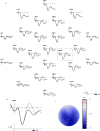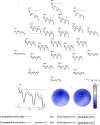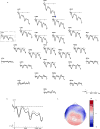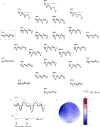Subject/object processing asymmetries in Korean relative clauses: Evidence from ERP data
- PMID: 25400303
- PMCID: PMC4231604
- DOI: 10.1353/lan.2013.0044
Subject/object processing asymmetries in Korean relative clauses: Evidence from ERP data
Abstract
Subject relative (SR) clauses have a reliable processing advantage in VO languages like English in which relative clauses (RCs) follow the head noun. The question is whether this is also routinely true of OV languages like Japanese and Korean, in which RCs precede the head noun. We conducted an event-related brain potential (ERP) study of Korean RCs to test whether the SR advantage manifests in brain responses as well, and to tease apart the typological factors that might contribute to them. Our results suggest that brain responses to RCs are remarkably similar in VO and OV languages, but that ordering of the RC and its head noun localizes the response to different sentence positions. Our results also suggest that marking the right edge of the RC in Chinese (Yang et al. 2010) and Korean and the absence of it in Japanese (Ueno & Garnsey 2008) affect the response to the following head noun. The consistent SR advantage found in ERP studies lends further support to a universal subject preference in the processing of relative clauses.
Figures


 ) and ungrammatical (‘*to-the.park’; dotted line
) and ungrammatical (‘*to-the.park’; dotted line
 ) phrases at all 26 electrode sites. (B) Grand average ERP waveforms for grammatical (
) phrases at all 26 electrode sites. (B) Grand average ERP waveforms for grammatical (
 ) and ungrammatical (
) and ungrammatical (
 ) phrases at the medial parietal electrode (the electrode in the dotted square in A). (C) Topographic scalp isovoltage map of the mean difference (Ungrammatical – Grammatical conditions, 500 – 800 ms).
) phrases at the medial parietal electrode (the electrode in the dotted square in A). (C) Topographic scalp isovoltage map of the mean difference (Ungrammatical – Grammatical conditions, 500 – 800 ms).
 ) and incongruous (book-ACC ate ‘ate a book’; dotted line
) and incongruous (book-ACC ate ‘ate a book’; dotted line
 ) sentence endings at all 26 electrode sites. (B) Grand average ERP waveforms for congruous (
) sentence endings at all 26 electrode sites. (B) Grand average ERP waveforms for congruous (
 ) and incongruous (
) and incongruous (
 ) endings at the right medial central electrode (the electrode in the dotted square in A). (C) Topographic scalp isovoltage map of the mean difference (Incongruous – Congruous conditions, 300 – 600 ms)
) endings at the right medial central electrode (the electrode in the dotted square in A). (C) Topographic scalp isovoltage map of the mean difference (Incongruous – Congruous conditions, 300 – 600 ms)
 ) and scrambled (dotted line
) and scrambled (dotted line
 ) word order sentences at the nominative-marked NP, all 26 electrode sites. (B) Grand average ERP waveforms for canonical (
) word order sentences at the nominative-marked NP, all 26 electrode sites. (B) Grand average ERP waveforms for canonical (
 ) and scrambled (
) and scrambled (
 ) word orders at the left medial frontal electrode (the electrode in the dotted square in A). (C) Topographic scalp isovoltage map of the mean difference (Scrambled – Canonical word order conditions, 300 – 600 ms). (D) Topographic scalp isovoltage map of the mean difference at ‘school-GEN’ (Scrambled –Canonical word order conditions, 800 – 1100 ms poststimulus onset of ‘principal-NOM’)
) word orders at the left medial frontal electrode (the electrode in the dotted square in A). (C) Topographic scalp isovoltage map of the mean difference (Scrambled – Canonical word order conditions, 300 – 600 ms). (D) Topographic scalp isovoltage map of the mean difference at ‘school-GEN’ (Scrambled –Canonical word order conditions, 800 – 1100 ms poststimulus onset of ‘principal-NOM’)
 ) and object relative clauses (‘publisher-NOM secretly politically exploit-ADN senator-GEN’; dotted line
) and object relative clauses (‘publisher-NOM secretly politically exploit-ADN senator-GEN’; dotted line
 ) at the left lateral frontal electrode.
) at the left lateral frontal electrode.
 ) and object relative clauses (‘publisher-NOM secretly’; dotted line
) and object relative clauses (‘publisher-NOM secretly’; dotted line
 ) at all 26 electrodes sites. (B) Grand average ERP waveforms for SRs (
) at all 26 electrodes sites. (B) Grand average ERP waveforms for SRs (
 ) and ORs (
) and ORs (
 ) at the left lateral frontal electrode (the electrode in the dotted square in A). (C) Topographic scalp isovoltage map of the mean difference (OR – SR conditions, 300 – 600 ms).
) at the left lateral frontal electrode (the electrode in the dotted square in A). (C) Topographic scalp isovoltage map of the mean difference (OR – SR conditions, 300 – 600 ms).
 ) and object relative clauses (dotted line
) and object relative clauses (dotted line
 ) at all 26 electrode sites. (B) Grand average ERP waveforms for SR (
) at all 26 electrode sites. (B) Grand average ERP waveforms for SR (
 ) and OR (
) and OR (
 ) conditions at the left lateral frontal electrode (the electrode in the dotted square in A). (C) Topographic scalp isovoltage map of the mean difference at the relative clause verb (OR – SR conditions, 300 – 600 ms). (D) Topographic scalp isovoltage map of the mean difference at the head noun (OR – SR conditions, 800 – 1100 ms post-stimulus onset of the relative clause verb).
) conditions at the left lateral frontal electrode (the electrode in the dotted square in A). (C) Topographic scalp isovoltage map of the mean difference at the relative clause verb (OR – SR conditions, 300 – 600 ms). (D) Topographic scalp isovoltage map of the mean difference at the head noun (OR – SR conditions, 800 – 1100 ms post-stimulus onset of the relative clause verb).
 ) and object relative clauses (dotted line
) and object relative clauses (dotted line
 ) at all 26 electrodes sites. (B) Grand average ERP waveforms for SR (
) at all 26 electrodes sites. (B) Grand average ERP waveforms for SR (
 ) and OR (
) and OR (
 ) conditions at the left lateral frontal electrode (the electrode in the dotted square in A). (C) Topographic scalp isovoltage map of the mean difference at the head noun (OR -SR conditions, 300 – 600 ms).
) conditions at the left lateral frontal electrode (the electrode in the dotted square in A). (C) Topographic scalp isovoltage map of the mean difference at the head noun (OR -SR conditions, 300 – 600 ms).Similar articles
-
Comprehension of Subject and Object Relative Clauses in a Trilingual Acquisition Context.Front Psychol. 2017 Oct 6;8:1641. doi: 10.3389/fpsyg.2017.01641. eCollection 2017. Front Psychol. 2017. PMID: 29056917 Free PMC article.
-
Disambiguation and Integration in Korean Relative Clause Processing.J Psycholinguist Res. 2017 Aug;46(4):827-845. doi: 10.1007/s10936-016-9461-z. J Psycholinguist Res. 2017. PMID: 27943081
-
The effect of noun animacy on the processing of unambiguous sentences: evidence from French relative clauses.Q J Exp Psychol (Hove). 2011 Oct;64(10):1896-905. doi: 10.1080/17470218.2011.608851. Epub 2011 Sep 7. Q J Exp Psychol (Hove). 2011. PMID: 21895558
-
Asymmetries in children's production of relative clauses: data from English and Korean.J Child Lang. 2016 Sep;43(5):1038-71. doi: 10.1017/S0305000915000422. Epub 2015 Aug 12. J Child Lang. 2016. PMID: 26264784
-
Is There a Processing Preference for Object Relative Clauses in Chinese? Evidence From ERPs.Front Psychol. 2018 Jul 9;9:995. doi: 10.3389/fpsyg.2018.00995. eCollection 2018. Front Psychol. 2018. PMID: 30038589 Free PMC article.
Cited by
-
Syntactic Comprehension of Relative Clauses and Center Embedding Using Pseudowords.Brain Sci. 2020 Mar 31;10(4):202. doi: 10.3390/brainsci10040202. Brain Sci. 2020. PMID: 32244525 Free PMC article.
-
Conversation electrified: ERP correlates of speech act recognition in underspecified utterances.PLoS One. 2015 Mar 20;10(3):e0120068. doi: 10.1371/journal.pone.0120068. eCollection 2015. PLoS One. 2015. PMID: 25793289 Free PMC article.
-
Attraction Effects in Honorific Agreement in Korean.Front Psychol. 2016 Aug 31;7:1302. doi: 10.3389/fpsyg.2016.01302. eCollection 2016. Front Psychol. 2016. PMID: 27630594 Free PMC article.
-
Relative Clause Sentence Comprehension by Japanese-Speaking Children With and Without Specific Language Impairment.J Speech Lang Hear Res. 2021 Jun 4;64(6):1929-1943. doi: 10.1044/2021_JSLHR-19-00054. Epub 2021 May 6. J Speech Lang Hear Res. 2021. PMID: 33956514 Free PMC article.
-
Time-Driven Effects on Processing Relative Clauses.J Psycholinguist Res. 2016 Oct;45(5):1033-44. doi: 10.1007/s10936-015-9391-1. J Psycholinguist Res. 2016. PMID: 26337288 Free PMC article.
References
-
- Altmann Gerry T, Kamide Yuki. Incremental interpretation at verbs: Restricting the domain of subsequent reference. Cognition. 1999;73:247–264. - PubMed
-
- Arnon Inbal. Relative clause acquisition in Hebrew: Towards a processing-oriented account. In: Brugos Alejna, Clark-Cotton Manuella R, Ha Seungwan., editors. Proceedings of the twenty-ninth Boston university conference on language development. Somerville, MA: Cascadilla Press; 2005. pp. 37–48.
-
- Bader Markus, Meng Michael. Subject-object ambiguities in German embedded clauses: an across-the-board comparison. Journal of Psycholinguistic Research. 1999;28:121–43.
-
- Berwick Robert, Weinberg Amy. The role of grammars in models of language use. Cognition. 1983;13(1):1–61. - PubMed
-
- Bresnan Joan, Kaplan Ronald. Introduction: Grammars as mental representations of language. In: Bresnan Joan., editor. The mental representation of grammatical relations. Cambridge, Mass: MIT Press; 1982. pp. xvii–lii.
Grants and funding
LinkOut - more resources
Full Text Sources
Other Literature Sources
Research Materials
